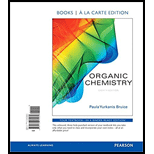
(a)
Interpretation:
The mechanism of the given reaction should be proposed.
Concept introduction:

In the presence of acid catalyst, this reaction takes place through partial

Epoxides are reactive, methoxide ion attacks epoxides in a less sterically hindered position which forms the alkoxide ion, and then it gets proton from alcohol which form the product.
(b)
Interpretation:
The structure of all products that formed in the given reaction should be drawn.
Concept introduction:

In the presence of acid catalyst, this reaction takes place through partial

Epoxides are reactive, methoxide ion attacks epoxides in a less sterically hindered position which forms the alkoxide ion, and then it gets proton from alcohol which form the product.
(c)
Interpretation:
The reason should be explained for the formation of six member ring compound in the given reaction.
Concept introduction:

In the presence of acid catalyst, this reaction takes place through partial

Epoxides are reactive, methoxide ion attacks epoxides in a less sterically hindered position which forms the alkoxide ion, and then it gets proton from alcohol which form the product.
Want to see the full answer?
Check out a sample textbook solution
Chapter 10 Solutions
ORGANIC CHEMISTRY (LL)-W/MOD.MASTERING.
- Draw the final products A and B for the following reactions.arrow_forwardAnswer each part for the reaction below. a. Draw in ALL missing lone pairs b. Draw appropriate curved arrows to complete the acid-base reaction c. Draw the corresponding products for the reactionarrow_forwardFor the reaction scheme below: (a) Suggest a reagent X that could be used to accomplish the first step. (b) Draw the curly arrow mechanism for the second step in the scheme.arrow_forward
- Draw the products of each reaction. (a) and (b)arrow_forwarddraw the remaining product of the reactionarrow_forwarda. Propose a mechanism for the following reaction: b. A small amount of a product containing a six-membered ring is also formed. Draw the structure of that product.c. Why is so little six-membered ring product formed?arrow_forward
 Organic Chemistry: A Guided InquiryChemistryISBN:9780618974122Author:Andrei StraumanisPublisher:Cengage Learning
Organic Chemistry: A Guided InquiryChemistryISBN:9780618974122Author:Andrei StraumanisPublisher:Cengage Learning
